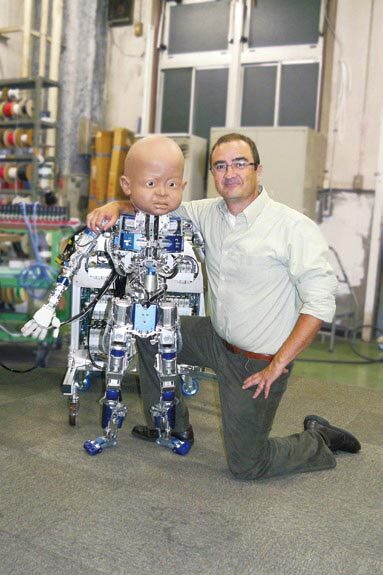A new android infant has been born thanks to the University of California San Diego's Machine Perception Lab. The lab received funding from the National Science Foundation to contract Kokoro Co. Ltd. and Hanson Robotics, two companies that specialize in building lifelike animatronics and androids, to build a replicant based on a one year old baby. The resulting robot, which has been a couple of years in development, has finally been completed – and you can watch it smile and make cute faces after the break.
Diego-san, as it's called, is actually much larger than a standard one year old – mainly because miniaturizing the parts would have been too costly. It stands about 4 feet 3 inches (130 cm) tall and weighs 66 pounds (30 kg), and its body has a total of 44 pneumatic joints. Its head alone contains about 27 moving parts. Hanson Robotics, which sells a line of expressive robots called Robokind, is responsible for Diego-san's head. You may recall the company's earlier work, such as their replicant of Philip K. Dick, or Albert Einstein – the latter a collaboration with KAIST's Hubo Lab. As a result of this expertise, Diego-san's face is much more realistic than other expressive robots like IURO.
The robot was designed as a research platform for studying the cognitive development of infants. This will involve UCSD's work with natural communication, such as reading and mimicking facial expressions, which is why the robot has such a realistic face.
Understanding brain development
"Its main goal is to try and understand the development of sensory motor intelligence from a computational point of view," explains Dr. Javier Movellan, who heads the UCSD Machine Perception Lab. "It brings together researchers in developmental psychology, machine learning, neuroscience, computer vision and robotics. Basically we are trying to understand the computational problems that a baby’s brain faces when learning to move its own body and use it to interact with the physical and social worlds."

Dr. Movellan's group has worked with children and robots for years. Previously, he was part of the RUBI Project, which had toddlers interact with the Sony QRIO (the ill-fated humanoid counterpart to the company's robotic dogs). It was found that children treated QRIO as if it was a living thing, and even tucked him in with a blanket when he laid down to "sleep" – though actually, his batteries simply needed recharging. Diego-san differs in that it will be mainly attended to by researchers as they would a child.
Kokoro Co. Ltd. designed and built Diego-san's intricate body, and they have some experience in this area, having previously designed and built the android infant CB2 for Osaka University. They were able to take what they learned from that robot and improved it with Diego-san, making it one of the most realistic android infants ever built.
"Diego-san was developed to approximate the complexity of a human body, including the use of actuators that have similar dynamics to that of human muscles," Dr. Movellan said.
Diego-san may be the first robot baby of the new year, but with Roboy scheduled for completion in a few months, and other android infants in progress, it won't be alone in the world for long. It remains to be seen if any of them can escape the dreaded Uncanny Valley.
Source: UCSD Machine Perception Lab via David Hanson (YouTube)


















